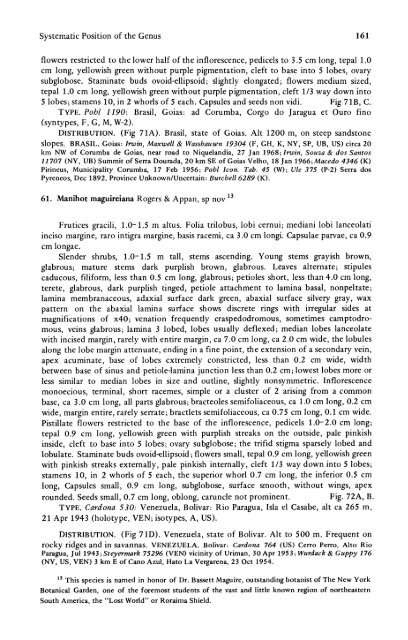Manihot Manihotoides (Euphorbiaceae) - CNCFlora
Manihot Manihotoides (Euphorbiaceae) - CNCFlora
Manihot Manihotoides (Euphorbiaceae) - CNCFlora
Create successful ePaper yourself
Turn your PDF publications into a flip-book with our unique Google optimized e-Paper software.
Systematic Position of the Genus 161<br />
flowers restricted to the lower half of the inflorescence, pedicels to 3.5 cm long, tepal 1.0<br />
cm long, yellowish green without purple pigmentation, cleft to base into 5 lobes, ovary<br />
subglobose. Staminate buds ovoid-ellipsoid; slightly elongated; flowers medium sized,<br />
tepal 1.0 cm long, yellowish green without purple pigmentation, cleft 1/3 way down into<br />
5 lobes; stamens 10, in 2 whorls of 5 each. Capsules and seeds non vidi. Fig 71B, C.<br />
TYPE. Pohl 1190: Brasil, Goias: ad Corumba, Corgo do Jaragua et Ouro fino<br />
(syntypes, F, G, M, W-2).<br />
DISTRIBUTION. (Fig 71A). Brasil, state of Goias. Alt 1200 m, on steep sandstone<br />
slopes. BRASIL. Goias: Irwin, Maxwell & Wasshausen 19304 (F, GH, K, NY, SP, UB, US) circa 20<br />
km NW of Corumba de Goias, near road to Niquelandia, 27 Jan 1968; Irwin, Souza & dos Santos<br />
11707 (NY, UB) Summit of Serra Dourada, 20 km SE of Goias Velho, 18 Jan 1966; Macedo 4346 (K)<br />
Pirineus, Municipality Corumba, 17 Feb 1956; Pobl Icon. Tab. 45 (W); Ule 375 (P-2) Serra dos<br />
Pyreneos, Dec 1892. Province Unknown/Uncertain: Burchell 6289 (K).<br />
61. <strong>Manihot</strong> maguireiana Rogers & Appan, sp nov 13<br />
Frutices gracili, 1.0-1.5 m altus. Folia trilobus, lobi cernui; mediani lobi lanceolati<br />
inciso margine, raro intigra margine, basis racemi, ca 3.0 cm longi. Capsulae parvae, ca 0.9<br />
cm longae.<br />
Slender shrubs, 1.0-1.5 m tall, stems ascending. Young stems grayish brown,<br />
glabrous; mature stems dark purplish brown, glabrous. Leaves alternate; stipules<br />
caducous, filiform, less than 0.5 cm long, glabrous; petioles short, less than 4.0 cm long,<br />
terete, glabrous, dark purplish tinged, petiole attachment to lamina basal, nonpeltate;<br />
lamina membranaceous, adaxial surface dark green, abaxial surface silvery gray, wax<br />
pattern on the abaxial lamina surface shows discrete rings with irregular sides at<br />
magnifications of x40; venation frequently craspedodromous, sometimes camptodromous,<br />
veins glabrous; lamina 3 lobed, lobes usually deflexed; median lobes lanceolate<br />
with incised margin, rarely with entire margin, ca 7.0 cm long, ca 2.0 cm wide, the lobules<br />
along the lobe margin attenuate, ending in a fine point, the extension of a secondary vein,<br />
apex acuminate, base of lobes extremely constricted, less than 0.2 cm wide, width<br />
between base of sinus and petiole-lamina junction less than 0.2 cm; lowest lobes more or<br />
less similar to median lobes in size and outline, slightly nonsymmetric. Inflorescence<br />
monoecious, terminal, short racemes, simple or a cluster of 2 arising from a common<br />
base, ca 3.0 cm long, all parts glabrous; bracteoles semifoliaceous, ca 1.0 cm long, 0.2 cm<br />
wide, margin entire, rarely serrate; bractlets semifoliaceous, ca 0.75 cm long, 0.1 cm wide.<br />
Pistillate flowers restricted to the base of the inflorescence, pedicels 1.0-2.0 cm long;<br />
tepal 0.9 cm long, yellowish green with purplish streaks on the outside, pale pinkish<br />
inside, cleft to base into 5 lobes; ovary subglobose; the trifid stigma sparsely lobed and<br />
lobulate. Staminate buds ovoid-ellipsoid; flowers small, tepal 0.9 cm long, yellowish green<br />
with pinkish streaks externally, pale pinkish internally, cleft 1/3 way down into 5 lobes;<br />
stamens 10, in 2 whorls of 5 each, the superior whorl 0.7 cm long, the inferior 0.5 cm<br />
long, Capsules small, 0.9 cm long, subglobose, surface smooth, without wings, apex<br />
rounded. Seeds small, 0.7 cm long, oblong, caruncle not prominent. Fig. 72A, B.<br />
TYPE. Cardona 530: Venezuela, Bolivar: Rio Paragua, Isla el Casabe, alt ca 265 m,<br />
21 Apr 1943 (holotype, VEN; isotypes, A, US).<br />
DISTRIBUTION. (Fig 71D). Venezuela, state of Bolivar. Alt to 500 m. Frequent on<br />
rocky ridges and in savannas. VENEZUELA. Bolivar: Cardona 764 (US) Cerro Perro, Alto Rio<br />
Paragua, Jul 1943;Steyermark 75296 (VEN) vicinity of Uriman, 30 Apr 1953; Wurdack & Guppy 176<br />
(NY, US, VEN) 3 km E of Cano Azul, Hato La Vergarena, 23 Oct 1954.<br />
13 This species is named in honor of Dr. Bassett Maguire, outstanding botanist of The New York<br />
Botanical Garden, one of the foremost students of the vast and little known region of northeastern<br />
South America, the "Lost World" or Roraima Shield.

















